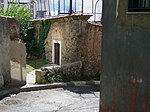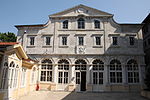The Cathedral Church of St. George (Greek: Καθεδρικός ναός του Αγίου Γεωργίου; Turkish: Aya Yorgi Kilisesi) is the principal Eastern Orthodox cathedral located in Istanbul, the largest city in Turkey and, as Constantinople, capital of the Byzantine Empire until 1453, and of the Ottoman Empire until 1922. Since about 1600, it has been the seat of the Ecumenical Patriarchate of Constantinople whose leader is regarded as the primus inter pares (first among equals) in the Eastern Orthodox Church, and as the spiritual leader of 300 million Orthodox Christians worldwide.The church, dedicated to the Christian martyr Saint George, is the site of numerous important services, and is where the patriarch will consecrate the chrism (myron) on Holy and Great Thursday, when needed. For this reason, the church is also known as the "Patriarchal Church of the Great Myrrh". At one time, the patriarch would consecrate all of the chrism used throughout the entire Orthodox Church. However, now the heads of most of the autocephalous churches sanctify their own myrrh.
The church is located in the Fener (Phanar) district of Istanbul, north-west of the historic centre of old Constantinople. (Its address is Fener Rum Patrikhanesi, Sadrazam Ali Pasa Cadesi, Fener 34220, Istanbul.) It is a relatively small church, especially so considering its status in world Christianity; this, however, can be explained by the Islamic laws of the Ottoman Empire that governed the rights of dhimmis, which stipulate that all non-Islamic buildings must be smaller and humbler than corresponding Islamic buildings such as mosques: prior to the Ottoman conquest of Constantinople in 1453, the church of the Patriarchate was the Hagia Sophia (also known as the Cathedral of Holy Wisdom).
The church is open to the public from 8.30 am to 4 pm, but strict security screening is in place, as a measure against the possibility of an attack from Islamic extremist groups. It is visited by a stream of pilgrims from Greece and other Orthodox countries. Behind the church are the offices of the Patriarchate and the Patriarchate Library. The church, which was part of a convent or monastery before becoming the seat of the Patriarch, is outwardly unimpressive, but its interior is lavishly decorated.









